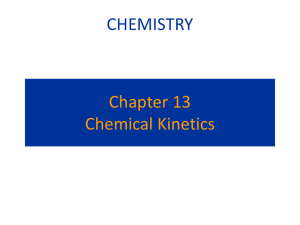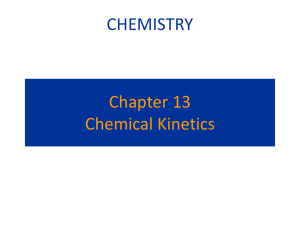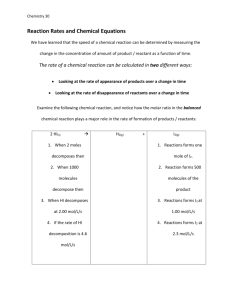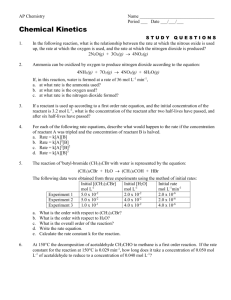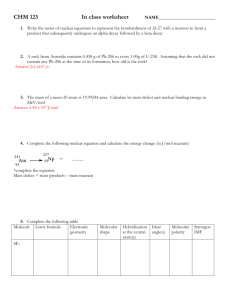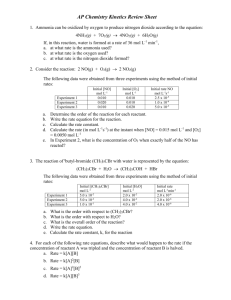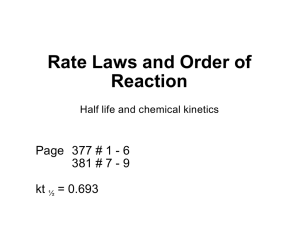Rate
advertisement
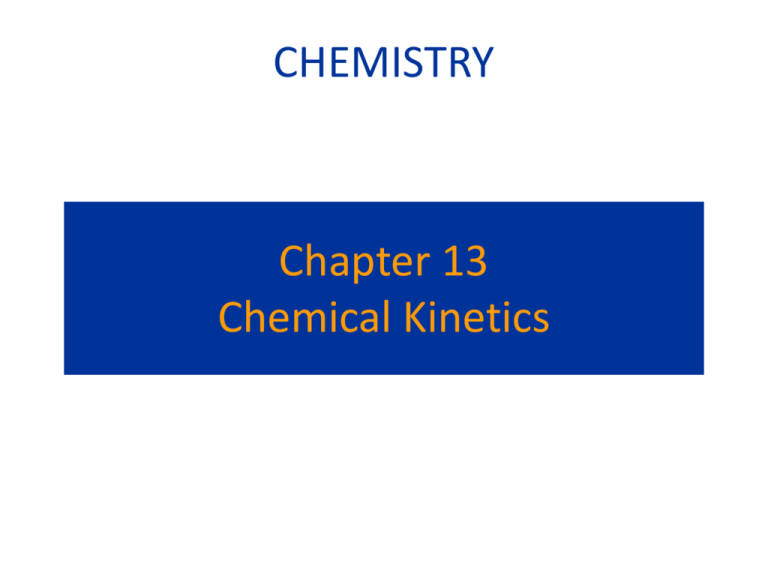
CHEMISTRY Chapter 13 Chemical Kinetics Factors that Affect Reaction Rates • Kinetics is the study of how fast chemical reactions occur. • There are 4 important factors which affect rates of reactions: – – – – reactant concentration, temperature, action of catalysts, and surface area. • Goal: to understand chemical reactions at the molecular level. Reaction Rates Change of Rate with Time • Consider: C4H9Cl(aq) + H2O(l) C4H9OH(aq) + HCl(aq) Reaction Rates • For the reaction A B there are two ways of measuring rate: – the speed at which the products appear (i.e. change in moles of B per unit time), or – the speed at which the reactants disappear (i.e. the change in moles of A per unit time). moles of A Average rate with respect to A t Reaction Rates Reaction Rate and Stoichiometry • In general for: aA + bB cC + dD 1 A 1 B 1 C 1 D Rate a t b t c t d t • Rate is (-) if reagent is consumed. • Rate is (+) if compound is produced. • Rate will ultimately be (+) because change in concentration will be negative. Two (-)’s become (+). Take Note: • Rate must ALWAYS be a positive value! Take Note! • Since the direction of equilibrium changes as more product is produced, rates have to be determined as soon as the experiment has begun. 2N2O5 4NO2 + O2 [N2O5] (mol/L) Time (sec) 0.100 0 0.0707 50 0.0500 100 0.0250 200 0.0125 300 0.00625 400 Sample Problem • A. How is the rate at which ozone (O3) disappears related to the rate at which O2 appears in the reaction: 2 O3 (g) 3 O2 (g)? • B. If the rate at which O2 appears, [O2]/t, is 6.0 x 10-5 M/s at a particular instant, at what rate is O3 disappearing at this same time, -[O3]/t? Answers • A. “Related to” means compare, so write the rate expression comparing the compounds. • B. 4.0 x 10-5 M/s Sample Problem • The decomposition of N2O5 proceeds according to the following equation: 2 N2O5 (g) 4 NO2 (g) + O2 (g) If the rate of the decomposition of N2O5 at a particular instant in a reaction vessel is 4.2 x 10-7 M/s, what is the rate of appearance of: (a) NO2, (b) O2 ? Differential Rate Law - is a rate law that expresses how rate is dependent on concentration Example: Rate = k[A]n Differential First Order Rate Law • First Order Reaction – Rate dependent on concentration – If concentration of starting reagent was doubled, rate of production of compounds would also double Concentration and Rate • • • • Using Initial Rates to Determines Rate Laws A reaction is zero order in a reactant if the change in concentration of that reactant produces no effect. A reaction is first order if doubling the concentration causes the rate to double. A reacting is nth order if doubling the concentration causes an 2n increase in rate. Note that the rate constant does not depend on concentration. Differential Rate Law • For single reactants: A C Rate = k[A]n • For 2 or more reactants: A + B C Rate = k[A]n[B]m Rate = k[A]n[B]m[C]p Experimental Data [NO2-]initial Initial Rate Expt. [NH4]initial 1 0.100 M 0.0050 M 1.35 x 10-7 2 0.100 M 0.010 M 2.70 x 10-7 3 0.200 M 0.010 M 5.40 x 10-7 Problem • NH4+ • • • • + NO2- N2 + 2H2O Give the general rate law equation for rxn. Derive rate order. Derive general rate order. Solve for the rate constant k. To Determine the Orders of the Reaction (n, m, p, etc….) • 1. Write Rate law equation. • 2. Get ratio of 2 rate laws from successive experiments. • Ratio = rate Expt.2 = k2[NH4+]n[NO2-]m rate Expt.1 k1[NH4+]n[NO2-]m • 3. Derive reaction order. • 4. Derive overall reaction order. • 5. Use one set of values, plug in the orders and solve for the rate constant. Experimental Data [NO2-]initial Initial Rate Expt. [NH4]initial 1 0.100 M 0.0050 M 1.35 x 10-7 2 0.100 M 0.010 M 2.70 x 10-7 3 0.200 M 0.010 M 5.40 x 10-7 A+BC Experiment Number [A] (mol·L-1) [B] (mol·L-1) Initial Rate (mol·L-1·s-1) 1 0.100 0.100 4.0 x 10-5 2 0.100 0.200 4.0 x 10-5 3 0.200 0.100 1.6 x 10-4 (a) Determine the differential rate law (b) Calculate the rate constant (c) Calculate the rate when [A]=0.050 mol·L-1 and [B]=0.100 mol·L-1 Use the data in table 12.5 to determine 1) The orders for all three reactants 2) The overall reaction order 3) The value of the rate constant 2NO(g) + 2H2(g) N2(g) + 2H2O(g) Experiment Number [NO] (mol·L-1) [H2] (mol·L-1) Initial Rate (mol·L-1·s-1) 1 0.10 0.10 1.23 x 10-3 2 0.10 0.20 2.46 x 10-3 3 0.20 0.10 4.92 x 10-3 (a) Determine the differential rate law (b) Calculate the rate constant (c) Calculate the rate when [NO]=0.050 mol·L-1 and [H2]=0.150 mol·L-1 Sample Problem:. Consider the general reaction aA + bB cC and the following average rate data over some time period Δt: Δ[A] 0.0080 mol L1 s 1 Δt Δ[B] 0.0120 mol L1 s 1 Δt Δ[C] 0.0160 mol L1 s 1 Δt Determine a set of possible coefficients to balance this general reaction. Problem • Reaction: A + B C obeys the rate law: Rate = k[A]2[B]. • A. If [A] is doubled (keeping B constant), how will rate change? • B. Will rate constant k change? Explain. • C. What are the reaction orders for A & B? • D. What are the units of the rate constant? You now know that…. • The rate expression correlates consumption of reactant to production of product. For a reaction: 3A 2B - 1[A] = 1[B] 3 t 2 t • The differential rate law allows you to correlate rate with concentration based on the format: Rate = k [A]n You also know that… • 1. Rate of consumption of reactant decreases over time because the concentration of reactant decreases. Lower concentration equates to lower rate. • 2. If a graph of concentration vs. time were constructed, the graph is not a straight line Expt. 25 1400 1200 Time in seconds 1000 800 Series1 600 400 200 0 0 0.002 0.004 0.006 0.008 Concentration (M) 0.01 0.012 0.014 Expt. 25 0.014 Concentration in Molarity 0.012 0.01 0.008 Series1 0.006 0.004 0.002 0 0 200 400 600 800 Time in seconds 1000 1200 1400 How can we make the line straight? What is the relationship between concentration and time? By graphing concentration vs. 1/time? Concentration vs. Reciprocal of Time 0.006 Reciprocal of Time (1/sec) 0.005 0.004 0.003 Series1 0.002 0.001 0 0 0.002 0.004 0.006 0.008 Concentration (M) 0.01 0.012 0.014 The Integrated Rate Law makes this possible! First Order Reaction -3 0 200 400 600 800 1000 1200 1400 1600 -3.5 ln[concentration] -4 -4.5 Series1 -5 -5.5 -6 -6.5 Time in seconds Integrated Rate Law • Expresses the dependence of concentration on time Integrated Rate Laws • Zero Order: [A]t = -kt + [A]o • First Order: ln[A]t = -kt + ln[A]o • Second Order: 1 [A]t = kt + 1 [A]o where [A]o is the initial concentration and [A]t is the final concentration. Integrated First-Order Rate Law • ln[A]t = -kt + ln[A]0 • Eqn. shows [concn] as a function of time • Gives straight-line plot since equation is of the form y = mx + b The Change of Concentration with Time Zero Order Reactions •A plot of [A]t versus t is a straight line with slope -k and intercept [A]0. The Change of Concentration with Time First Order Reactions •A plot of ln[A]t versus t is a straight line with slope -k and intercept ln[A]0. The Change of Concentration with Time Second Order Reactions •A plot of 1/[A]t versus t is a straight line with slope k and intercept 1/[A]0. Temperature and Rate Activation Energy • How does a molecule gain enough energy to overcome the activation energy barrier? • From kinetic molecular theory, we know that as temperature increases, the total kinetic energy increases. • We can show the fraction of molecules, f, with energy equal to or greater than Ea is f e E a RT where R is the gas constant (8.314 J/mol·K). Temperature and Rate Determining the Activation Energy • If we have a lot of data, we can determine Ea and A graphically by rearranging the Arrhenius equation: Ea ln k ln A RT • From the above equation, a plot of ln k versus 1/T will have slope of –Ea/R and intercept of ln A. Temperature and Rate Determining the Activation Energy • If we do not have a lot of data, then we recognize Ea Ea ln k1 ln A and ln k2 ln A RT1 RT2 Ea Ea ln k1 ln k2 ln A ln A RT1 RT2 k1 Ea 1 1 ln k2 R T2 T1 Reaction Mechanisms Elementary Steps • Elementary step: any process that occurs in a single step. Molecularity: the number of molecules present in an elementary step. – Unimolecular: one molecule in the elementary step, – Bimolecular: two molecules in the elementary step, and – Termolecular: three molecules in the elementary step. • It is not common to see termolecular processes (statistically improbable). Reaction Mechanisms Rate Laws for Elementary Steps Reaction Mechanisms Rate Laws for Elementary Steps • The rate law of an elementary step is determined by its molecularity: – Unimolecular processes are first order, – Bimolecular processes are second order, and – Termolecular processes are third order. Rate Laws for Multistep Mechanisms • Rate-determining step: is the slowest of the elementary steps.
